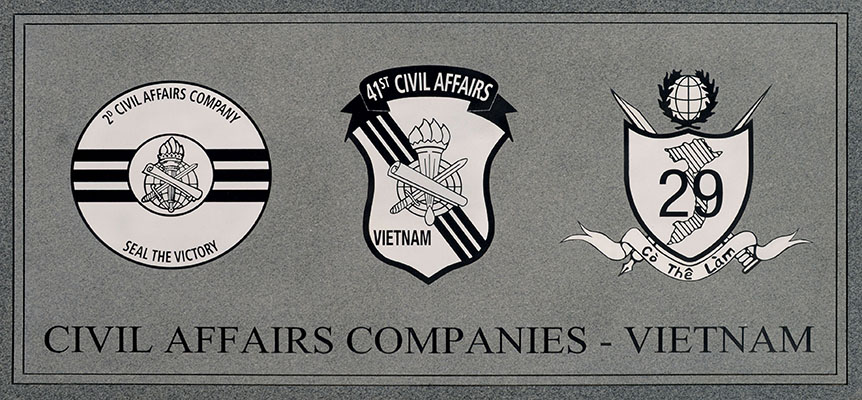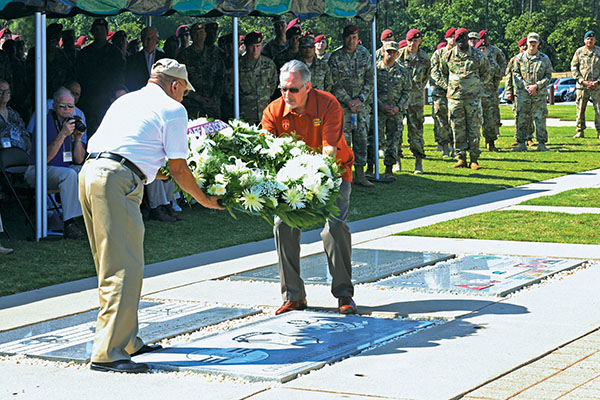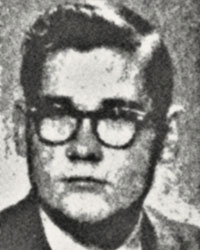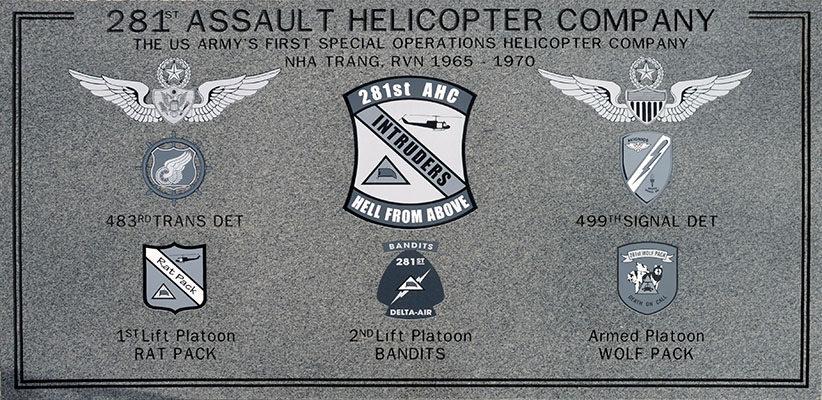DOWNLOAD
The United States Army Special Operations Command (USASOC) is committed to honoring its legacy. Recently, it added two memorial stones for units that served in Vietnam, and added the names of three PSYOP soldiers who were killed in that war. The addition of John A. Blanco, Jr., John E. Lynch, and Darel L. Sills to the Memorial Wall along with the installation of the Vietnam Civil Affairs and 281st Assault Helicopter Company stones in the Memorial Plaza underscore the USASOC commitment to honor, preserve, and build on the ARSOF legacy. They highlight Vietnam War service. Although that war ended more than forty years ago, these memorials will educate, remind, and inspire today’s ARSOF soldiers.
SPECIAL OPERATIONS AVIATION
On 7 October 2016, a stone paver dedicated to the 281st Assault Helicopter Company (AHC), the ‘Intruders,’ became the latest addition to the USASOC Memorial Plaza. Activated on 7 October 1965, the 281st served in Vietnam from 1965 to 1970. Based in Nha Trang, Republic of Vietnam, operational control (OPCON) of 5th Special Forces Group (SFG), its primary mission was to support Army Special Operations Forces. Units supported included the 5th SFG, the Military Assistance Command Vietnam (MACV), Studies and Observations Group (SOG), the MACV Recondo School, and other 5th SFG ‘Greek’ projects like Delta, Omega, and Sigma. Later, the company provided combat helicopter support throughout II Corps Tactical Zone (II CTZ).
The 281st AHC was organized into lift, attack, maintenance, and service elements. The 1st Platoon (nicknamed ‘Rat Pack’) and the 2nd Platoon (‘Bandits’) provided lift support with UH-1B Iroquois ‘Huey’ helicopters. The third platoon (‘Wolf Pack’) supported ground operations with armed UH-1C ‘Huey’ gunships. The 483rd Transportation and 499th Signal Detachments provided logistical and communications support.1
The 281st AHC was inactivated in Vietnam on 14 December 1970 after five years of dedicated combat service. The ‘Intruders’ participated in twelve Vietnam campaigns and received a Valorous Unit Award, a Meritorious Unit Commendation, four awards of the Republic of Vietnam Cross of Gallantry with Palm, and a Republic of Vietnam Cross of Gallantry with Gold Star. It was later activated in the Army Reserve on 15 April 1971 and based in Saint Louis, MO. It was inactivated on 30 September 1987 at Scott Air Force Base, IL.2

CIVIL AFFAIRS
On 3 June 2016, veterans of the three Civil Affairs (CA) Companies that served in Vietnam, the 41st, 2nd, and 29th, dedicated a memorial stone in the U.S. Army Special Operations Command (USASOC) Memorial Plaza. These active-duty U.S. Army CA Companies promoted rural pacification in the Republic of Vietnam from 1965 to 1971. They now join other Army Special Operations Forces (ARSOF) lineage and legacy units on the plaza. Thus, they help USASOC remember its predecessor elements and draw inspiration from them.
FM 41-10 Civil Affairs Operations (May 1962) assigned CA a key role in guerrilla and counter-guerrilla operations. They were to “engender stable conditions which are unfavorable to guerrilla activities through the relief of local destitution, restoration of law and order, resumption of agricultural production, reestablishment of local government, and measures to enlist the active support and sympathy of the local population.”3 As such, CA served as a force multiplier in Vietnam and regularly worked with Special Forces in the field.

Organized as individual companies, the three CA units essentially functioned as separate battalions. Commanded by a Lieutenant Colonel, each CA Company served at the Corps level in Vietnam. The 29th was assigned to the I CTZ, the 41st to the II CTZ, and the 2nd to the III CTZ. Initially part of the U.S. Military Assistance Command, Vietnam (MACV), the CA Companies were transferred to the Civil Operations and Revolutionary Development Support (CORDS) program at the end of 1967. The civilian–led, three-star equivalent command, CORDS, controlled all civilian and military rural pacification programs from the military, Department of State, Central Intelligence Agency (CIA), and the U.S. Agency for International Development (USAID). Under CORDS, CA personnel coordinated and supervised village stability projects that included roads and bridge construction, well digging and water purification, animal husbandry, basic education, and medical clinics. The local Vietnamese-driven projects were designed to stimulate the regional economies and earn respect for the Saigon government.
The 41st CA Company arrived in 1965 and the 2nd and 29th followed in 1966.4 With Vietnamization and the withdrawal of U.S. military forces (a pre-condition for peace negotiations with Hanoi), the 41st CA Company was disbanded in 1970, followed by the 2nd and 29th in 1971. All three Vietnam-era CA companies are in the lineage of current active-duty CA battalions. The 81st and 83rd CA Battalions, 85th CA Brigade, perpetuate the lineages of the 29th and 41st Companies, respectively.5 The 92nd CA Battalion, 95th CA Brigade, continues the lineage of the 2nd Civil Affairs Company.
PSYCHOLOGICAL OPERATIONS
USASOC memorialized three Psychological Operations (PSYOP) soldiers who died in Vietnam. These are: First Lieutenant (1LT) John A. Blanco, Jr., Sergeant (SGT) John E. Lynch, and Specialist Four (SP4) Darel L. Sills. Their names will be forever enshrined on the USASOC Memorial Wall.

John A. Blanco, Jr., was born in Evanston, IL, on 10 May 1943. Earning a B.A. in Psychology in 1966 from Lewis College (now University), Romeoville, IL, he served as an enlisted Infantryman from 13 May 1966 to 27 April 1967. Successfully completing Infantry Officer Candidate School (OCS) at Fort Benning, GA, Blanco was commissioned as an Infantry second lieutenant (2LT). His first assignment after OCS was Headquarters and Headquarters Company (HHC), 13th PSYOP Battalion (POB), Fort Bragg, NC. In July 1967 he began the PSYOP Officers’ Course at the U.S. Army Special Warfare Center and School at Fort Bragg. Two months later he was awarded the Military Occupational Specialty (MOS) of Psywar/PSYOP Officer.
On 24 April 1968, Blanco began his tour of duty in Vietnam. Promoted to 1LT, he was assigned as a Coordination Officer in the Propaganda Development Center (PDC), 7th POB, a subordinate unit of the new 4th PSYOP Group (POG). Over the next several months, his assignments in 7th POB included Audio-Visual Field Team Leader; Detachment Commander; and Assistant Development Officer in the PDC. On 17 December 1968, 25-year-old 1LT Blanco was killed in a military aircraft crash in Quang Tin, I CTZ.6

John E. Lynch was born on 19 July 1948 in Kingston, PA. While a senior at Wyoming Valley West High School, he enlisted as a private via the U.S. Army Reserve Delayed Entry Program. After high school graduation on 6 June 1968, he entered the Regular Army in Wilkes-Barre, PA, for an active-duty term of 3 years. He chose Intelligence Analyst as his MOS and did Basic Combat Training at Fort Gordon, GA.
On 24 September 1968, Lynch began the Intelligence Analyst Course at the U.S. Army Intelligence School (USAINTS) at Fort Holabird, MD, earning a promotion to Private First Class. He completed USAINTS on 27 November 1968 and was promoted to Specialist Four (SP4). After graduation, Lynch received orders to U.S. Army, Vietnam (USARV). Arriving in January 1969, he was assigned to B Company, 6th POB, 4th POG, as a Section Leader. He conducted numerous aerial loudspeaker and leaflet missions, and was awarded the Air Medal on 29 April for the period of 18 January to 1 March 1969.
Lynch was conducting a leaflet drop/loudspeaker mission on 15 June 1969, in III CTZ aboard a UH-1 ‘Huey’ Iroquois belonging to B Company, 229th Aviation Battalion, 1st Cavalry Division (Airmobile). Around 1430 hours, the helicopter hit high voltage wires, crashed, and burned. Lynch was killed, along with Warrant Officer 1 (WO1) Kish L. Green (pilot), SP4 Larry D. Lemaster (gunner), and RVN interpreter My Vu Tan. Amazingly, WO1 William K. Geloneck (pilot) and SP4 Larry M. Pollitt (crew chief) survived with serious burns. Lynch was posthumously promoted to Sergeant and awarded the Military Merit Medal by the Republic of Vietnam.7

Darel L. Sills was born in Shattuck, OK, on 1 September 1941. After graduating high school in 1959, Sills attended Portland (OR) State University, 1962-1963, before joining the Army as a Private (E-2) on 31 December 1964 to become a Still Photographic Specialist. After MOS training, Sills was promoted to SP4 in November 1965.
On 27 June 1966, Sills arrived in Vietnam assigned to the 246th PSYOP Company, 6th POB, USARV. While supporting the 173rd Airborne Brigade (Separate), SP4 Sills “planned and participated in numerous psychological warfare operations against the Viet Cong, and often accompanied airborne speaker and leaflet drop missions over hostile territory. Entering insecure hamlets with his team, the PSYOP team leader would attempt to persuade the villagers to sever ties with the Viet Cong and support the Vietnamese government.” On 13 October 1966, 25-year-old SP4 Sills was killed when the military vehicle in which he was riding hit an explosive mine. Sills’ skill badges and decorations included the Aircraft Crewman Badge, the Air Medal, the Purple Heart, the Army Commendation Medal, and the Republic of Vietnam Military Merit Medal, and Gallantry Cross with Palm.8

